N-1wsletter #13: Budget Shimano for road and gravel, inexpensive steel gravel bikes, miniature mini-pumps, and jerseys made like socks
It’s a big week on the value-oriented side of things.
Featured in this week’s tech round-up:
Utility and cargo bike components should be built for durability, not low cost.
Shimano expands its CUES range of value-oriented components to drop-bars.
State Bicycle Company debuts its redesigned budget-friendly steel gravel bikes.
How small can a mini-pump be and still be useful?
A new high-end component brand with some interesting names behind it.
Cane Creek gets friendly with Shimano.
A cycling jersey that’s made like a sock.
An unusual – but very useful – piece of winter cycling clothing.
Pretzel buns!
I wrote in last week’s newsletter about the need to regularly service and maintain your mountain bike suspension forks and rear shocks – not because I’m trying to drive business to your local bike shop, but because taking care of those bits will unquestionably save you money in the long run. One n-1 subscriber brought up a very valid point as a result of that discussion, however: that suspension arguably has no business on any sort of cargo or utility bike.
On the one hand, I can speak from firsthand experience that suspension can and does provide a big benefit in that application. Cargo and utility bikes are often stiff and heavy, and big loads can be quickly unsettled on surfaces that are anything but smooth.
But almost by definition, those bikes also lead awfully hard lives. They’re ridden in all sorts of weather conditions. They’re often beasts of burden, regularly performing arduous tasks with little love shown in return. And despite being used in some of the most demanding situations, the components built for that market are often cheap and of relatively poor quality.
Case in point: A friend of mine, Josh Crane, runs a coffee roastery and delivery service here in Boulder, Colorado called The Coffee Ride. His business focuses heavily on sustainability, and part of his business plan was weekly deliveries by bike for each order – every Thursday morning, through rain, snow, wind, cold, heat, or whatever (unless conditions are truly unsafe, in which case he resorts to the old standby). His business has since grown to the point where he’s now regularly shipping beans nationwide, but the local by-bike delivery is still going so well that his original Urban Arrow has since been joined by four additional e-cargo bikes.
By Josh’s calculations, those bikes have now covered more than 46,000 km (28,600 mi) in total over 11 years, and just on Thursdays.
As anyone running a small business can attest, that sort of life is an endless hustle with no time to spare – certainly not for suspension maintenance, and not when your customers are expecting to open their front door on a Thursday morning and see their freshly roasted beans waiting for them in the early-hours sunlight.
The Spinner 300 fork on Josh’s Urban Arrow features an all-aluminum chassis instead of cast magnesium lowers that are more prone to corrosion, as well as a steel coil spring instead of a more maintenance-intensive air setup – both smart moves for that sort of application. However, the lower legs are still sealed with the same rubber wiper seals found on most forks, and they’ve been woefully unable to contend with Mother Nature (not to mention neglect). The fork barely moves at all these days, and the stanchions are so visibly worn that they’re measurably smaller in diameter. It hasn’t aged well.
Is it too much to ask that something like that be more mindfully engineered to prioritize longevity and weather resistance? How difficult would it be to use some kind of fully sealed boot system instead of just wipers? Or if you wanted to get really fancy, perhaps even some kind of rudimentary valve system that lets you drain old (and dirty) oil bath fluid and replace it with fresh stuff without requiring disassembly?
Shouldn’t something intended for heavy-duty utilitarian use be designed to last a long time in realistic conditions? I know the economics of such a thing aren’t there; premium utility bikes aren’t exactly a red-hot market. And even with good e-cargo bikes being as expensive as they are, it’s still a niche segment overall, and few product managers are interested in hiking retail prices up even more. That said, a guy can dream, no?
Keep chugging along, Josh. But sometime sooner than later, you should probably think about replacing that thing before it snaps in half and you scatter coffee beans all over the road.
In the news
Shimano expands CUES and ESSA component families to the drop-bar world
Shimano’s value-oriented CUES range of componentry has already brought impressive levels of refinement and precision to the mountain bike and urban markets, and the Japanese juggernaut is now promising to bring that same level of performance to 9-, 10-, and 11-speed road and gravel bikes.
The new CUES 6000-series drop-bar components feature 10- or 11-speed cassettes, mechanical shifting in both 1x and 2x variants, and hydraulic disc brakes across the board. Visually, the new levers are a spitting image of the higher-end Tiagra levers, but with a shorter lever reach to better accommodate smaller hands.
Meanwhile, the new CUES 3000-series stuff is built around 9- and 10-speed cassettes and mechanical disc brakes, but still with options for both 1x and 2x cranksets.
Drivetrain longevity is a prime focus (hallelujah) courtesy of Shimano’s LinkGlide cassette design. This uses teeth that are not only taller than on Shimano’s upper-end cassettes, but also thicker at the base so as to spread out chain forces over a larger surface area – something the company also uses on its e-bike components.
Just as with CUES flat-bar parts, cross-compatibility is a big selling point – not just for consumers, but also for stocking dealers looking to minimize how much money they have tied up in repair parts. However, that cross-compatibility only extends within the CUES family, not to any previous 9-, 10-, or 11-speed components.
“Consolidating its 9-, 10-, and 11-speed component ranges with interchangeable components, including common derailleur pulleys, cassette sprockets and chains, Shimano CUES reduces shop inventory needs and simplifies the servicing process for mid-tier bikes,” read the Shimano press release. “The lineup features unified sprocket spacing across its 9-, 10-, and 11-speed drivetrains – Shimano’s most compatible and versatile component lineup – meaning that components can be intermixed across a wider range of user groups and riding styles.”
Rounding out Shimano’s release of value-oriented drop-bar components is a new ESSA drivetrain, built exclusively on a 1x8 mechanical transmission and a single 11-45T wide-range cassette, both of which should be more appealing and easier to understand for beginner riders than more complicated 2x systems. ESSA sticks with Shimano’s more conventional Hyperglide cassette design, but the cassette spacing will work with 6-, 7- and 8-speed chains for easier sourcing of replacements.
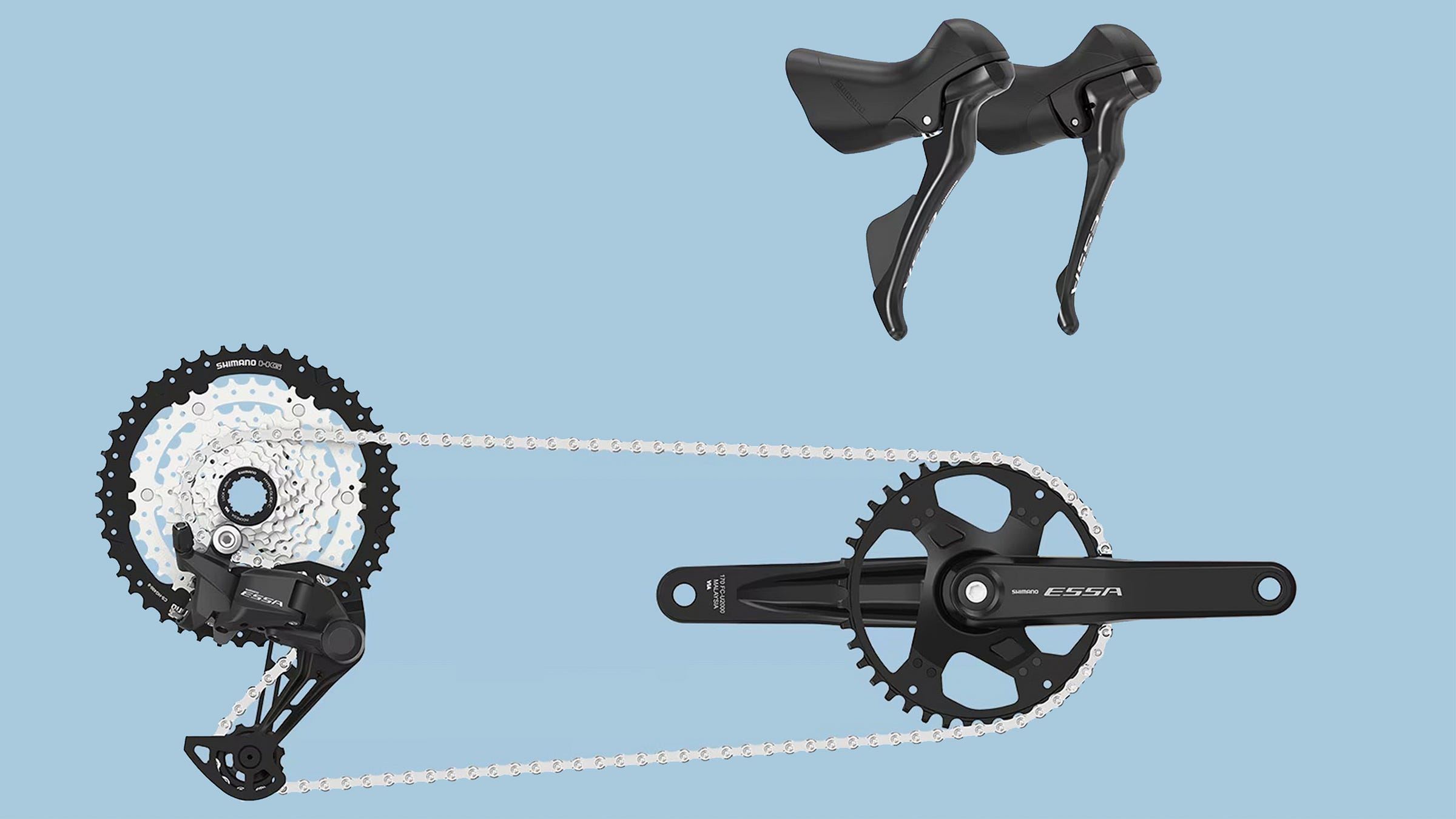
CUES and ESSA will primarily be found on complete bikes – not purchased aftermarket – and Shimano says to expect to see the new bits on bikes from Trek, Specialized, Giant, Cannondale, Marin, Salsa, Surly, Fuji, and Wilde beginning around April.
State Bicycle Company revamps its 4130 All-Road steel gravel bike
Looking to get into gravel on a budget? That end of the price spectrum is State Bicycle Company’s bread and butter, and it’s just announced a redesigned 4130 All-Road range of steel gravel bikes with attainable prices that start at US$1,000.
The new frames feature TIG-welded straight-gauge chromoly construction, and they’re also matched with TIG-welded chromoly forks (carbon forks are optional). SBC has incorporated UDH-compatible rear dropouts to make it easier to source replacement parts, there’s dedicated routing for internal dropper posts should you choose to add one, and there’s no shortage of accessory mounts. Official tire clearance is an impressive 2.4” with 650b rims, but a more modest 45 mm with 700c ones. And though the geometry leans more toward the traditional end of things with fairly short reach dimensions and tall stacks, that’s probably just fine for riders seeking out a more casual steed.
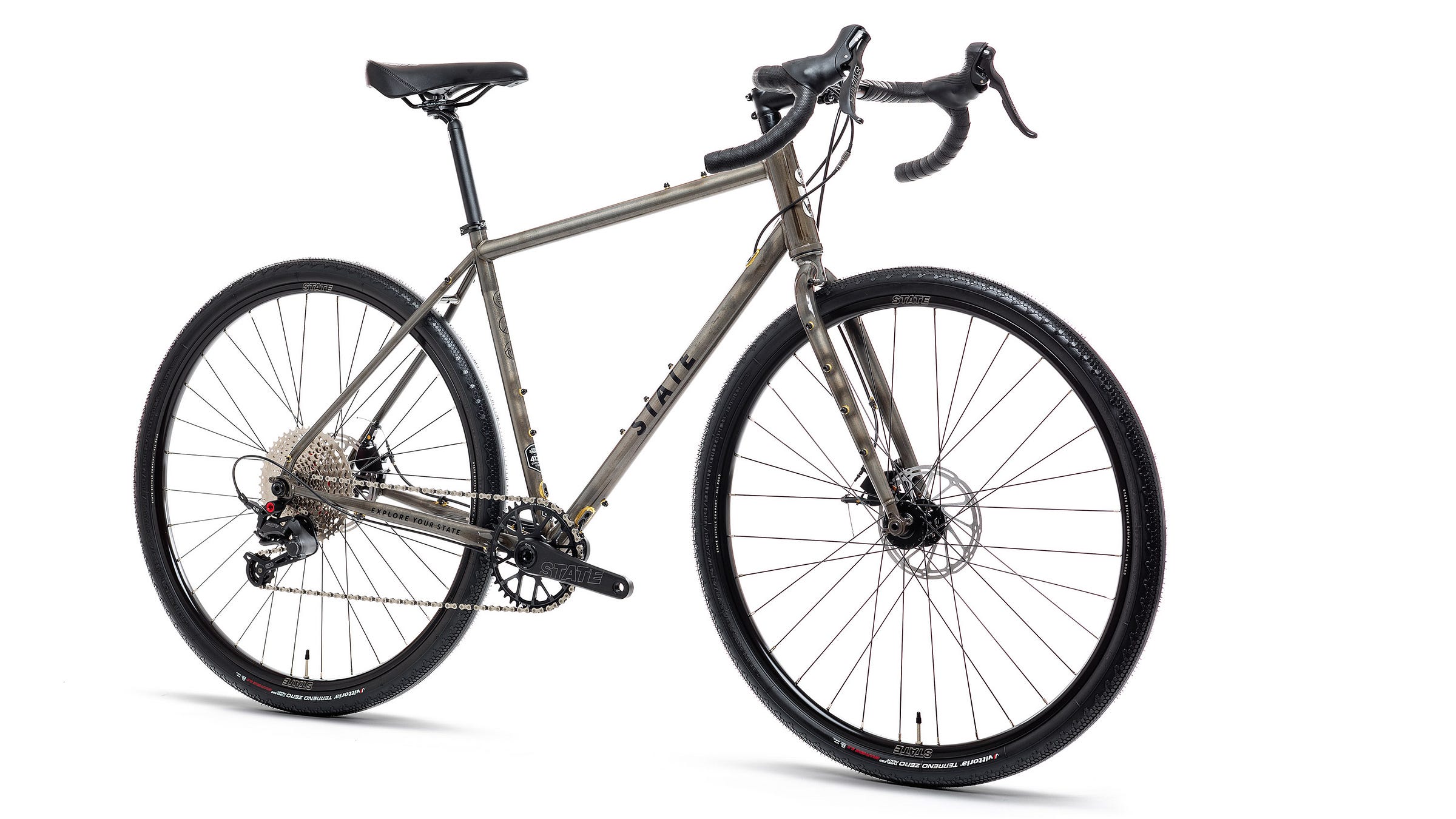
State Bicycle has updated the build kits, too, with wider rims (23 mm internal for 700c, 25 mm for 650b), higher spoke counts to improve wheelset durability, better quality hubs (with faster engagement and more bearings), hybrid mechanical/hydraulic disc brake calipers with compressionless housing all around, and 12-speed drivetrains (made by Sensah) with wide-range 11-46T or 11-50T cassettes matched to more usable 40T chainrings instead of the previous 42T ones for easier climbing.
Oh, and State Bicycle is selling the new 4130 All-Road models in both flat-bar and drop-bar versions, too.
Are these going to be heavy and probably pretty slow? Oh, you betcha. But they could also be pretty fun to ride regardless, and if the reasonable price points get someone else into riding bikes, I’m all for it.
Should I bring one in for a review? Let me know your thoughts.
Wolf Tooth Components announces teeny, tiny EnCase 30 cc pump
Wolf Tooth Components has expanded its range of EnCase mini-pumps with a new 30 cc version that joins the existing 40 and 85 cc models. Despite measuring just 120 mm in total length and weigh just 87 g (claimed), Wolf Tooth says the minuscule 30 cc EnCase pump is not only well-suited for gravel and MTB (maximum rated pressure is a modest 70 psi), but also that its careful design moves a lot more air than you might expect from something so small.
Despite the short length, the large-diameter hollow aluminum shaft still has enough room inside for a quick-draw tubeless plug kit, and like with other EnCase pumps, the internals are fully sealed from the elements with a cleverly threaded rubber collar to ensure the pump actually works when you need it to. Wolf Tooth has gone with a simple press-on, Presta-only head, though the shape is designed to be easy to grip, and included with the pump is a typical offset mount that tucks in beside your bottle cage (an inline one is sold separately).
What I think I appreciate most about the EnCase pump, however, is that Wolf Tooth makes available to the public every single small part used to make the thing, all accessible on its web site via a simple pull-down menu and easily identifiable with clearly labeled exploded diagrams. Crashed and dented a body? Got a worn-out pump head or piston gasket? Had a particularly flat-prone season and your bushing is now a little sloppy? No problem at all, and the parts aren’t even expensive. Heck, Wolf Tooth will even sell you just the little rubber strap used on its bottle cage mount instead of making you buy a whole new one.
The new EnCase 30 cc pump isn’t cheap to buy initially at US$65 / £59 / €74 / AU$125, but the fact you stand a greater than zero chance of having it for many years is a huge plus in my book.
Bravo.
Rotor founders embark on a new project
I first met Pablo Carrasco and Ignacio Estellés almost 20 years ago in a hotel bar on the island of Mallorca off the coast of Spain. At the time, they were two entrepreneurs with a budding startup trying to get the Saunier Duval-Prodir road racing team to adopt their then-novel Q-Ring oval chainring concept. I don’t remember if the pair were successful in that endeavor, but two decades later, the company they founded – Rotor Bike Components – seems to be doing just fine.
Carrasco and Estellés have both since moved on from Rotor, and they’re now launching a new component brand called QO.
QO is launching out of the gate with three cranksets: one for road, one for gravel, and one for MTB, all with bladder molded carbon fiber arms made in Asia by veteran composites manufacturer YMA, aluminum chainrings machined in Spain, and oversized aluminum spindles based on SRAM’s DUB system.
The QO Race road crankset is clearly aero-minded, with a solid outer chainring (bolted to a Shimano-standard four-arm 110 mm BCD aluminum spider) and prominent dimples throughout the entire crankset that “reduce drag and save watts” (and no, there was no data provided). They’re decently light with a claimed weight of 624 g (170 mm, 50/34T), the Q-factor is totally normal at 149 mm, and they’re offered in a broad range of arm lengths from 175 mm all the way down to 160 mm. According to QO, the 54/40T, 52/36T, and 50/34T chainrings are compatible with both Shimano and SRAM 12-speed chains and derailleurs. Retail price is £650 / €750 with arms, spider, and chainrings (distribution outside of the UK and EU is still being finalized).
The Grava crankset is aimed at, well, gravel bikes, with similarly dimpled carbon fiber arms and a direct-mount 1x chainring for use with Shimano and SRAM drivetrains. The ends of the crankarms are reinforced with woven aramid (more commonly known as Kevlar) to prevent damage from rock strikes and other impacts. These are offered in a narrower range of arm lengths – 165 to 172.5 mm – with 40, 42, or 44T chainrings. Claimed weight is 478 g (170 mm, 40T), and retail price is £600 / €700 for arms and a 1x chainring.
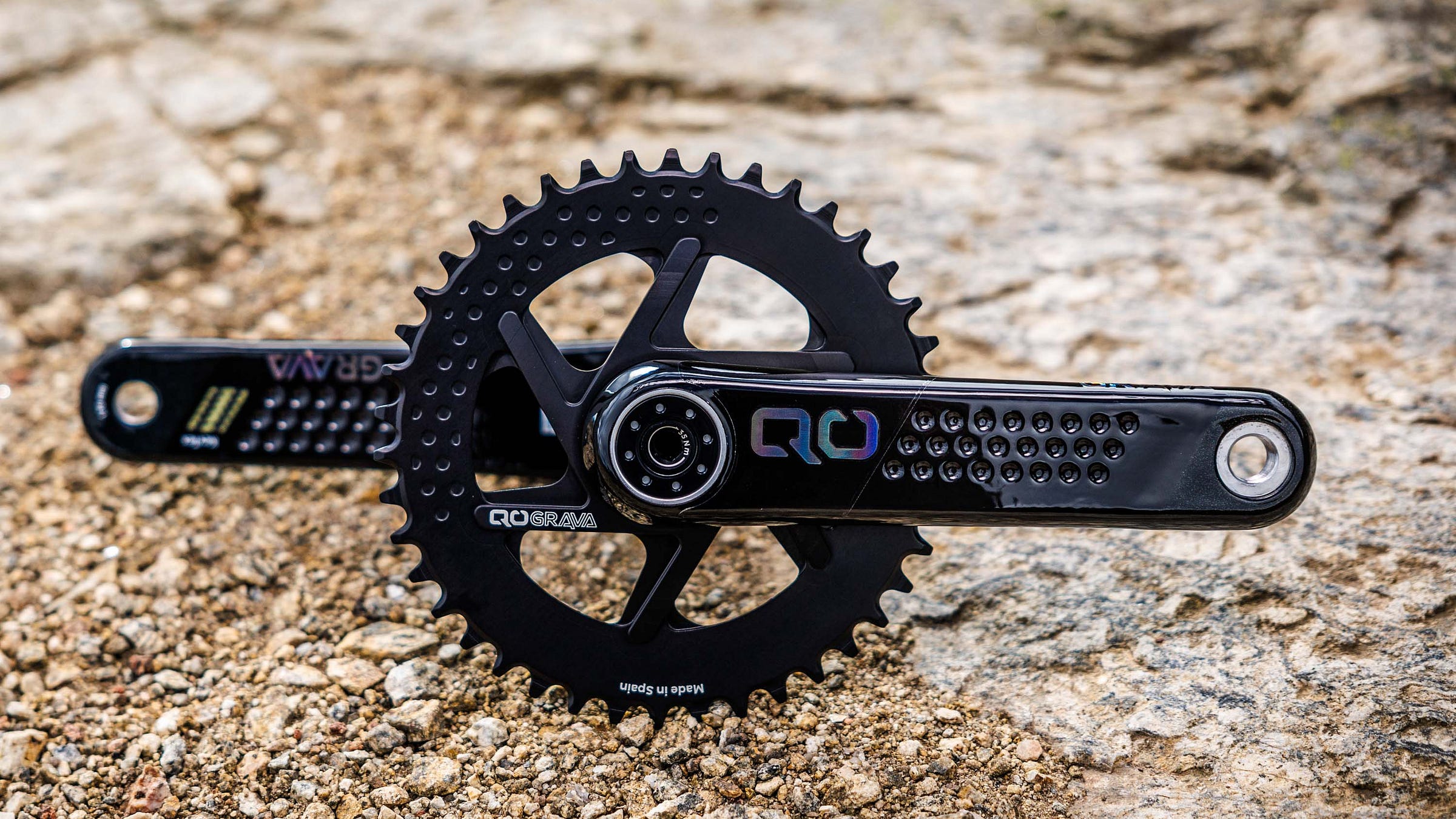
Finally, there’s the Rocks crankset for “aggressive” mountain biking, which foregoes the aero dimples for a series of indented slots that QO says boosts arm stiffness and improves impact resistance by acting as a sort of temporary crumple zone should you smash the end into something. Aramid reinforcement is used here, too, and there are supplemental rubber boots for additional protection. Arms are made in 165, 170, and 175 mm lengths, and the Shimano/SRAM-compatible direct-mount rings are offered in 32-38T, all with a 55 mm chainline. Claimed weight is 444 g with 170 mm arms and a 34T ring, and retail price for the combo is £560 / €650.
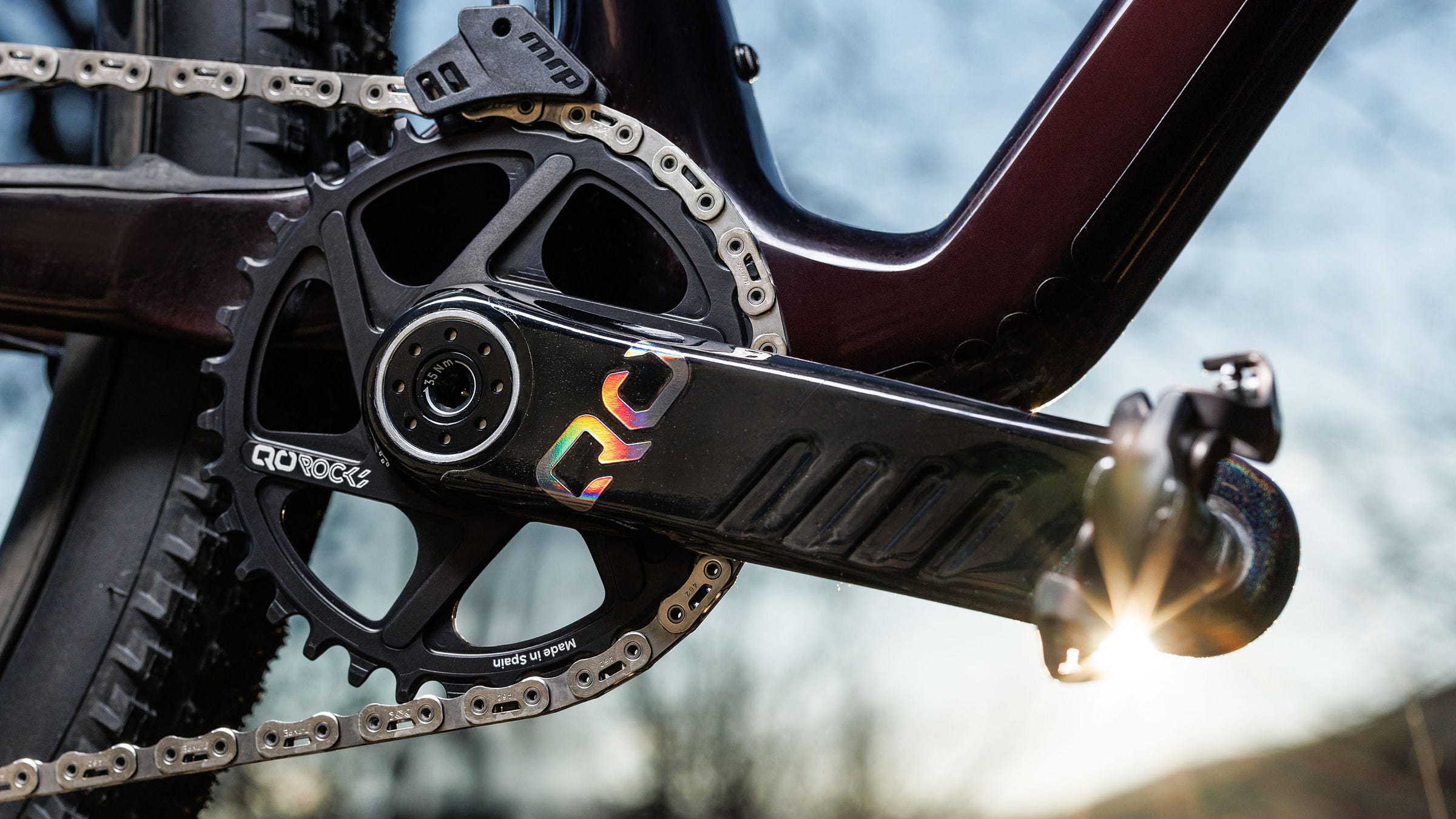
As much as I welcome an experienced newcomer in the space (not to mention more competition), I still can’t help but wonder if QO makes sense given how the segment is already so saturated. Nor does it help that existing options are also very good, and that QO’s pricing isn’t exactly disruptive.
“While QO is a new name, its entity – the people behind it – are not,” explained QO business development marketing manager Phillips Lucas. “We’ve started afresh to bring back our old momentum, innovate freely, and make waves again. We as a crew are still the trailblazing team we were known as being before. Our first three products set a brand tone: premium materials, top-tier manufacturing, and meticulous finishing. Mitsubishi carbon fiber, laid and impregnated on-site at one of the very best composite product factories, high-quality chainrings from our trusted Spanish manufacturing partner, and standout surface treatments express and define the integral quality QO offers.
“This lineup evolves from our heritage but pushes further,” he continued. “The Kevtex and MaxStrength Slots on the MTB crank are examples of offering a proper new concept in an existing product category. We’ve also refined layups with the vision of subtly balancing stiffness with vibration damping – an approach embraced in frames and wheels but as far as I know, underexplored in cranks. Instead of loading our marketing with abstract-even-if-measured percentage gains, we focus on real, tangible benefits.”
Marketing mumbo-jumbo or real-world benefits? I guess time will tell. I will say, though, that Carrasco and Estellés have always struck me as two honest people that are genuinely interested in making good-quality products, so I wish them well.
Cane Creek adds a GRX-compatible spider for its eeWings cranks
Speaking of high-end cranks, one that’s already been on the market for several years now is also one of the most distinctive: Cane Creek’s eeWings, built with welded tubular titanium for the arms and 30 mm-diameter spindle instead of the usual carbon fiber or aluminum.
Cane Creek equips the eeWings with a SRAM-standard three-bolt splined interface on the driveside arm. That common pattern opens a lot of doors in terms of direct-mount chainrings, but if you want to use a separate spider, Cane Creek has only offered to date five-bolt setups that are more limiting in terms of chainring selection.
The company has now added a second spider built around Shimano’s popular GRX four-arm 110/80 mm BCD, for use with 1x or 2x drivetrains. This one’s aluminum like the rest of Cane Creek’s eeWings spiders, but with more rounded and softer-looking edges as compared to the sharper lines featured elsewhere.
Retail price on the new GRX-compatible spider is a bit more than others at US$70 instead of US$56.
Attaquer introduces OrbKnit low-waste (not low-waist!) knit jersey construction
I’ve long had a soft spot in my heart for brands like Ornot and VéloColour for their regular use of off-cuts and deadstock materials to produce new clothing and accessories. It’s fabric that would otherwise end up in a landfill somewhere, and instead is repurposed into something that’s not only useful, but also arguably desirable for its inherently limited nature.
But what if you could make clothing without producing that waste in the first place? That’s what Australian cycling apparel brand Attaquer is attempting with its new OrbKnit jersey.
I’ve had some knit cycling apparel over the years, but it’s mostly been limited to simpler stuff like base layers, warmers, gloves, and socks. According to Attaquer, however, its new OrbKnit jersey, “incorporates varying textures, strategically placed mesh panel sections guided by sweat-rate mapping, and integrated compression zones – all seamlessly woven into
a single fabric.”
In other words, instead of using patterns to cut specifically shaped pieces of individual fabrics from larger rolls, stitching them together, and then trimming and discarding the leftover bits, OrbKnit forms the garment all at once directly from different types of threads. Almost nothing is tossed away as a result, and since it’s all done on-site, there’s less transportation cost, too.
The new OrbKnit jersey isn’t just made of a single material or fabric, either, instead including, “integrated textures, targeted compression, and optimized ventilation for a second-skin fit.”
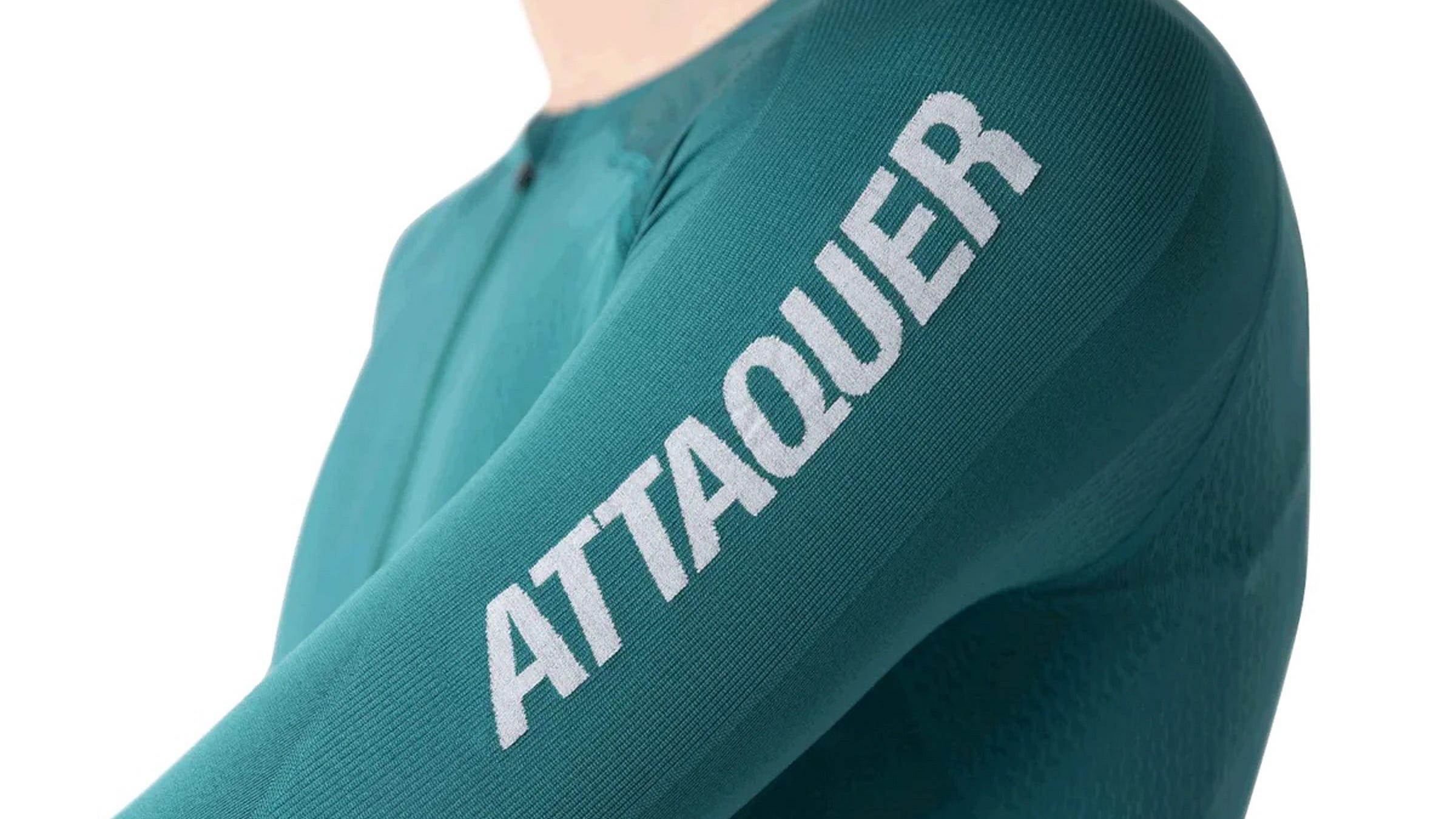
That said, Attaquer’s OrbKnit jersey doesn’t do away with conventional stitching altogether.
“Currently there are some technical limitations so we have to utilize stitching – grippers, etc,” Attaquer marketing manager Kate Barnes told me. “We have kept some trims such as the reflective binding for visibility and some extra stability on the rear pocket as reflective yarns are not a suitable solution.
“The main panels do come out of the machine with these details,” she continued. “For example, the body comes out of the machine as a tube and we cut down down the middle to stitch in the full length zipper.”
Retail price for the short-sleeve version is US$170 / £140 / €170 / AU$220 or US$195 / £155 / €195 / AU$250 if you want long sleeves. Both will be available in two colors: black and emerald.
A word of warning: I haven’t yet had a chance to ride in this new jersey (because winter), but I’ve at least been able to try it on, and Attaquer isn’t kidding with that “second-skin” fit descriptor (guess it’s time for me to hit the gym). I comfortably wear a medium in nearly every cycling apparel brand, but went with a large in the sample I just received per Attaquer’s suggestion. Even so, pulling it out of the package, it still looked like something I would have put on my kid when she was a toddler. But the material is extremely stretchy so the snugness doesn’t feel at all excessive, the fit is impressively even, and the material feels quite cozy (aside from the cold plastic zipper against your skin).
One last thing I should mention: while it’s admirable that Attaquer is seeking out ways to reduce material waste and conserve resources with this new OrbKnit technology, the best way to reduce consumption is to just consume less in general. In other words, don’t fool yourself into thinking you’re saving the planet by purchasing something like this, but if you were already in the market for a new jersey, anyway, have at it.
TL;DR review: Warmfront chest warmer
When it comes to dressing for inclement weather, I’m a much bigger fan of layers over more specialized all-in-ones: they’re far more practical, much more versatile, and way more affordable, particularly when you factor in all the different conditions for which the right assortment is suitable (and the replacement or repair cost should you shred something in a crash).
When the temperature drops really, really low, one of my favorite pieces over the past couple of years has been the aptly named Arctic Max chest warmer from little-known brand Warmfront.
The idea behind the Arctic Max is pretty simple: it’s basically a rectangular panel of Polartec Windbloc fleece stitched to a waffle-texture neck gaiter. The gaiter obviously keeps your neck warm (along with the lower part of your face should you choose to pull it up), but the magic lies in how the Windbloc panel helps to keep your core from getting a chill. If worn underneath a jersey, it keeps cold breezes from blowing all the way through to your body if you’re not already wearing a wind-resistant jacket or vest, and even if you are, the fleece material adds a tangible amount of cozy warmth.
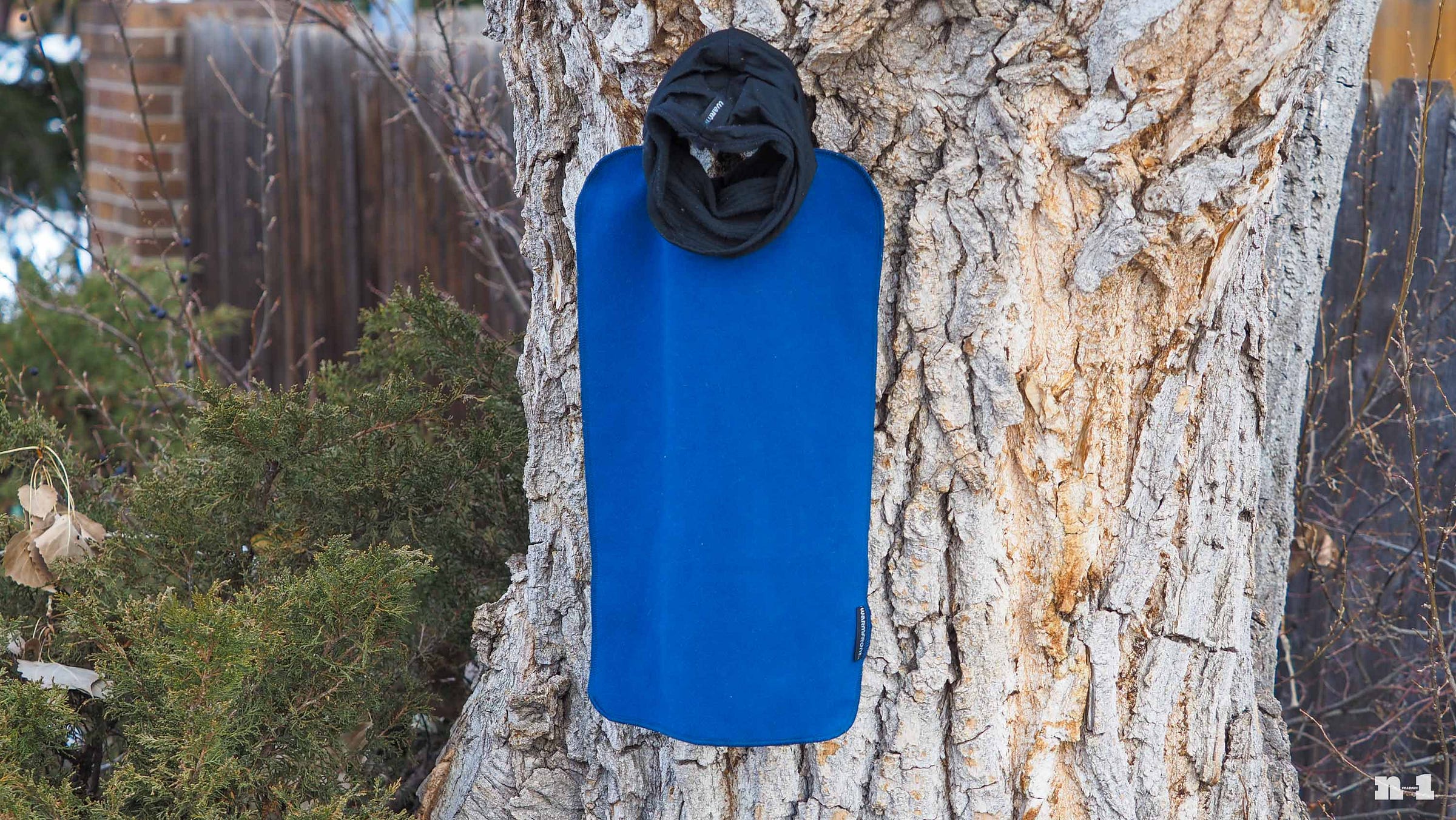
It’s been just the thing whenever a lighter jacket doesn’t seem like quite enough but a heavier one seems like too much, when I want to pack an emergency layer just in case, or any time I want just a little more warmth without sacrificing too much breathability. Put in more practical terms, it’s been a fantastic piece to put on at the top of a long road climb before turning around for a cold descent, and I’ve even found it super useful for skiing, too. If you take the time to fold it up carefully, it also fits neatly in a jersey pocket.
It doesn’t sound like much – and certainly doesn’t look like it – but it’s frequently been just enough. Almost never have I ever felt like it was too much, either, and breathability from the Windbloc fabric is pretty good, too.
The Arctic Max is Warmfront’s heaviest-duty warmer, and also its most expensive at US$56 (though I’d argue it’s been such a versatile and durable piece that the price doesn’t feel offensive). The company also offers lighter-duty options for roughly half that cost that are better suited for milder conditions and for really fine-tuning your temperature regulation. Of the ones I’ve tried, though, the Arctic Max still strikes me as having the biggest impact in the saddle.
I know it’s a little weird, and be forewarned that your friends will almost certainly poke some fun at you. But you can have the last laugh when you’re nice and cozy and they’re still shivering at the bottom.
Upcoming
I’ve got an awful lot of reviews to write up over the next few weeks and months, but far and away, the one you all have been pressing on me hardest to finish up is the Enve MOG gravel bike so assuming no weird hiccups over the next few days, I’ll plan to have that one ready to post early next week.
I was originally planning to do that one as a head-to-head against my personal Santa Cruz, but alas, winter arrived here in Colorado before I could get the Stiggy reconfigured for a more direct comparison. No worries, though; I’ve amassed more than enough time on the MOG to form a thorough opinion of it.
I’ll go into a lot more detail next week, but let’s just that while the Enve is hella expensive, it’s also one of the lightest, smoothest, and fastest-feeling gravel bikes I’ve ridden in recent memory.
Recipe of the week: German pretzel buns
There’s almost never a time when I order a burger at a restaurant that I don’t go for the pretzel bun upgrade if it’s available. They’re just… better. And after a few too many burger nights at home when I was disappointed with store-bought buns (in terms of taste, texture, and cost), I was determined to just start doing them myself.
This recipe been my go-to for the past couple of years.
There are quite a few steps so the whole process is a bit time-consuming, though it’s not all that different from gluing tubulars in the sense that it’s a big gap from start to finish, but not a ton of actual work time in between. And the result is well worth the effort.
I follow the recipe pretty closely for the dough, though I use AP flour and it seems just fine. I also boil the buns in the baking soda bath for a bit longer than recommended for a slightly darker crust, and for sure, absolutely don’t try to take a shortcut on the pretzel salt; only the real thing will do.
I’d advise using a kitchen scale so you can portion out the buns more evenly (I weigh my mixing bowl beforehand so it’s easier to measure the weight of the full batch of dough), and no worries if you don’t have a bread lame on hand; a sharp (and clean!) razor blade will work just fine for scoring. Keep in mind that if you do follow the recipe for portioning, the buns end up sized more like dinner rolls. If you want to use them for burgers or something similar, I’d divide the dough into eight (or maybe even six) equal portions instead of the recommended ten.
My biggest challenge the first few times I tried making pretzel buns was in the shaping: to be perfectly frank, I really sucked at it initially. But as is often the case with this sort of thing, King Arthur Flour’s YouTube channel is very helpful, and after a quick tutorial, I’ve gotten pretty consistent.
Once you get things dialed in, you might want to consider doubling the recipe. These don’t last long in my house, and I’d imagine they won’t in yours, either.
And that’ll do it for another n-1wsletter (lucky number 13, even!). Hope you found it informative, and maybe even a little entertaining, as you head into the weekend. Got a complaint or a suggestion? Feel free to yell at me directly via email. But if you’re enjoying these just fine as is, please let me know in the comment section below – or better yet, tell your riding buddies about n-1 so I can give them the straight scoop, too.
As always, these weekly newsletters are entirely free for all n-1 subscribers, and they arrive straight into your inbox each Friday morning (US time). And if you prefer to just pull the articles up in a browser window instead of looking at it in email form, you can always just head here instead.
Hope everyone has a great weekend, and see you all in a few days.
















Spot on about pretzel buns. They are just better
The Warmfront chest warmer is just what I’ve been looking, for but didn’t know existed. Can’t wait till mine arrives.